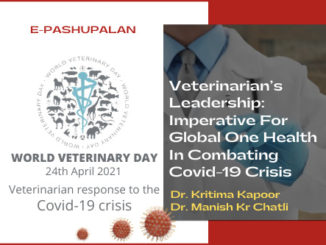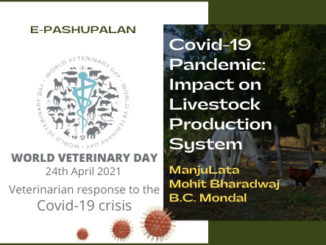Introduction
The pandemic of COVID-19 demonstrates that human, animal, and environmental health are inextricably related, highlighting the need for multidisciplinary cooperation in the One Health approach. How, however, will veterinarians’ interface in a positive and pro-active way with COVID-19 or possible pandemics in the human health sector and work on the same epidemiological surveillance programme? In view of the COVID-19 animal roots and of the predominance of zoonoses in emerging infections, their essential task in surveillance of diseases such as zoonotic diseases is to ensure that veterinarians play a leading role. They have long-term experience and know-how in dealing with the survival of pathogenic viruses (epidemiological surveillance) in wild animals on one hand and with epidemics triggered by emerging or exotic pathogens in fully susceptible animal populations on the other. This will greatly contribute towards the research and implementation of the sampling techniques for monitoring animal epidemics and the adaptation to the COVID-19 epidemic of SARS-CoV-2 animal reservoir. Indeed, the contribution of public health veterinarians from a One Health perspective can be imagined and substantiated through various levels of expertise, including viral surveillance of wildlife, management and control of past animal epidemics, laboratory services to diagnose and characterise pathogens such as SARS-CoV-2, the processing of human and animal COVID-19 tests, animal research, and so on.
Wildlife surveillance via viral transmission
It is estimated that zoonotic pathogens are responsible for about 75% of infectious pathogens in humans. Humans are coming into closer contact with animals carrying microbes that can be transmitted to people as a result of environmental damage caused by intensive agriculture, land clearing, deforestation, wildlife trade, and climate change. Given that an estimated 1.7 million viruses have yet to be detected in mammalian and avian hosts, up to 850000 may be capable of causing the next animal-human spill-over. Bats, for example, are a main reservoir for suspected dangerous viruses such as malaria, yellow fever, and chikungunya. Bats are a vital reservoir for known dangerous viruses including malaria, yellow fever, chikungunya, Zika, Ebola, and Nipah virus, which are among the species targeted. Bats have very weak immune and inflammatory responses to many viruses, allowing them to withstand, bear, and transmit viruses that are highly pathogenic to other species. This is a serious threat to human and animal health, particularly when human activities destroy their environment, allowing viruses to jump from natural hosts to humans on a regular basis. When humans hunt, sell, and eat wild animals, this creates a dangerous situation. When this is combined with human hunting, selling, and consumption of wild animals, the conditions are ideal for coronavirus transmission, either directly from bats to humans, as with Ebolavirus, or indirectly by proximity to intermediate hosts, as with SARS, MERS, and Nipah virus. To predict and avoid potential pandemics caused by new viruses, researchers must first learn about their origins, evolutionary diversity, and geographic spread in reservoir species, as well as identify hotspots where proactive zoonotic disease surveillance can be directed. Veterinary virologists play an important role in organising integrated surveillance studies on the aetiology of viral zoonoses and their effects on animal, human, and ecosystem health since they research virus evolution, especially the distribution and pathogenesis of viruses in domestic and wild animals.
Opening the livestock epidemic toolbox for public health
Veterinarians are experienced in the area of past infectious and viral disease epidemics (eg., bluetongue, fatal and mouth diseases, infectious bovine pleuro-pneumonia) and Zoonoses (eg., avian and swine flu, brucellosis and tuberculosis, BSE). Learned by so many animal health crises, they have gained a special ability to ‘get ready in the field’ and to conduct a variety of activities, including diagnostics, epidemiological studies, molecular/antigenic characterisation, surveillance preparation in a timely manner. They have, for example, successfully used a range of surveillance approaches to better understand how viral agents spread and to promote evidence-based, reliable, long-term, and timely efforts to reduce the prevalence or eliminate infectious diseases in animal populations. The human health system has traditionally focused on treating individual patients, with interventions aimed at the whole population being uncommon. In veterinary medicine, on the other hand, the health management policy is aimed at the entire animal population at risk, since epizootic diseases are expensive for livestock and the agricultural sector in general, as well as companion animals and their owners. In veterinary medicine, on the other hand, the health management policy is aimed at the entire animal population at risk, since epizootic diseases are expensive for livestock and the general agricultural sector, as well as companion animals and their owners, despite the low risk to public health. In practice, monitoring an infectious outbreak necessitates an understanding of the epidemic’s existence, size, and complexities in order to reduce disease incidence (i.e., the proportion of cases present in a given animal population at any given time) and provide timely evidence to decision-makers for adopting measures to reduce the economic and animal health burden. In light of the experiences veterinarians acquired in disease epidemiology within populations, using active and passive surveillance systems and risk analyses, veterinary medicine could make a valuable contribution to public health expertise in control of infections in people. The advantages of conducting repeated random surveys for disease control are well established in animal health veterinary surveillance, and public health bodies and decision-makers should consider their utility when appropriately applied to the human COVID-19 epidemic.
The veterinary contributions on vaccines
The availability and best use of vaccines, medicines, and bio-safety measures are related to limiting episodes of viral transmission inter-species (wild animals -domestic animals) and preventing farms from being a source of global health problems, according to the veterinary strategy for animal health, which is based on the idea “prevention is better than cure.” International collaboration, harmonised standards regulating animal husbandry, markets, and transportation, and developments in veterinary medicine are all aimed at preventing diseases on farms, like zoonosis, from spreading internationally in the same way and at the same pace as COVID-19. Animal research and the use of animal models, especially those susceptible to SARS-CoV-2, such as ferrets, non-human primates, pigs, and rodents, as well as the availability of artificial intelligence programmes and algorithms, clearly support the advancement of human therapies and vaccines in relation to a variety of disorders in the case of COVID-19. Indeed, animal testing has aided in the creation of vaccinations against human diseases such as polio, measles, tuberculosis, meningitis, and the human papillomavirus, which have saved millions of lives, and more recently, animal vaccines against zoonoses such as Ebola, which is consistent with the One Health approach.
SARS-CoV-2 detection and characterization at the molecular level
The global capacity of health-care systems has been severely strained by the COVID-19 pandemic, especially in countries that were unprepared to slow the virus’s spread and “flatten the curve” of new cases. Aside from hospital overcrowding, urgent problems including a shortage of equipment and supplies, disposable personal protective equipment, and the large workload of COVID-19 tests came to the forefront. During the crisis, the veterinary industry played a vital role in One Health. Veterinary laboratories in several countries tested human samples for SARS-CoV-2 in order to help public health laboratories to cope up with their heavy workload. To help public health laboratories cope up with the increased workload, veterinary laboratories in several countries tested human samples for SARS-CoV-2, collaborated on standard diagnostic and data-sharing protocols, and provided masks and other protective gear to hospitals, as well as key equipment such as respirators.
Awareness of animal import risk assessment to combat COVID-19
International travel poses a significant threat to the spread of SARS-CoV-2. The government should use veterinary expertise in animal import risk evaluation to develop a COVID-19 risk plan for international air travel. Animal import risk methodology can be easily revised and adapted to COVID-19 prevalence estimates for countries to evaluate the effects of any future changes in international travel policy or disease incidence.
Conclusion
Solidarity is crucial to the emerging pandemic. The OIE commemorates the great effort the veterinary fraternity has made to promote the field of human health and science, human sample testing and the supply of human and material resources to mark the 25 April World Veterinary Day. Over the past 3 months, COVID-19 has placed enormous pressure on fitness providers worldwide. So far, about 200 countries have proposed COVID-19 in human cases, with a load of hundreds of deaths. It was also suggested that the COVID-19 (SARS-CoV-2) virus originated in the animal supply, assuming that it was miles away and that some animals were contaminated by humans, and that the pandemic is being pushed by human-to-human contact. To date, there is no proof that animals are playing a significant role in the transmission of the disease. The unheard nature of this pandemic and the mysteries around this virus require new and revolutionary tactics to tackle it; these will most effective via cross sectoral collaboration and collective action of veterinary medicine along with human medicine.






Be the first to comment